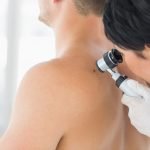When it’s Not Prostate Cancer
Clinical rule out strategies for an elevated tPSA
Phranq D. Tamburri, NMD
Your 60-year-old male patient presents to you with an ‘elevated’ total prostate specific antigen (tPSA) of 3.5 ng/ml. Although his digital rectal exam (DRE) was negative, his primary care practitioner sent him to a urologist who ordered a reflex prostate biopsy. The patient refused this procedure and has sought your opinion. What is your next step? What are the chances this patient does have cancer of the prostate (CaP)? What other conditions might have caused such an increase in tPSA? How do you rule these out with high confidence without putting your patient (or your license) at risk for a missed CaP? Finally, what are some basic core strategies to approach prostate pathology differentials? My approach will be from a clinical rather than an academic perspective.
The numerous methods for Advanced Prostate Cancer Assessment (APCA) have been outlined in detail in prior NDNR men’s health issues (September 2007, November 2008). This year’s installment will narrow down the other common elevated tPSA culprits: trauma / prostate muscle spasm, prostatitis, and benign prostatic hypertrophy (BPH).
Rule Out #1: Trauma / Prostate Muscle Spasm
This rule out is first because it is the most obvious as long as you take a proper history. Yet after years in practice I still marvel at the biopsy requests pressured onto men that have a clear ‘Before / After’ reason for a marked increase in tPSA values.
Rule Out #2: Prostatitis
Prostatitis is a very real condition that must always be ruled out, at least as a contributory factor when an elevated tPSA results. However, what makes this condition the most devilish of the four mentioned (including CaP) is the subtlety and concomitant nature of this diagnosis. It is thought to exist with most men at some point in their lives but in a subclinical nature. This suggests that when CaP is present, prostatitis can likely be contributing to the overall tPSA value. If prostatitis is suspected then the amount of ‘prostatitis’ tPSA could be qualitatively subtracted from the ‘overall’ tPSA yielding a clearer picture of the potential CaP effect on tPSA. However, it must be stressed that an aggressive CaP itself can also elicit an inflammatory condition due to the internal cellular battle raging at the neoplasm front which would yield an additive effect upon tPSA. Lastly, inflammation of the prostate can potentiate other pathology, most notably BPH, and result in significantly elevated Tpsa values. For example, if an inflamed gland can increase tPSA by say 10 – 20% within a
20 ml gland (normal size), then consider the increased tPSA detected for a 50 ml BPH, or an extreme ‘hyper’ BPH volume of 130 ml. I have seen negative biopsy cases of glands the size of the latter with prostatitis involvement resulting in potentiating tPSA values from 15 ng/ml to even 20+ ng/ml. This is the atypical situation so CaP vigilance must still be observed with any such patient case.
Causes of Prostatitis
The etiology for prostatitis is both varied and often idiopathic. Some common and currently understood causes are the following:
Infection
Although this is the first ’cause’ laymen associate with this condition, in actuality less than 10% of cases are bacterial in nature. Nevertheless, if the urinalysis demonstrates the usual suspects for a urinary tract infection (UTI) such as present leukocytes, hematuria, and nitrates, this may be the obvious culprit. In addition, ask the patient’s sexual hygiene and history if applicable, including their partner. Women can have ongoing / chronic UTIs (due to their shorter urinary tract and perineal anatomy) that they may pass cyclically to your patient. Lastly, be forewarned that some cases of bacterial prostatitis do not demonstrate a clear UTI suspect dip test.
Inflammation Through Physical Irritation
I like to give the analogy to my patients of their prostate gland being like a kitchen sponge on their sink. It may appear dry however, a small pressure downward can cause water to push out the base. Physical pressure onto the prostate, like the spasm examples earlier, has the potential to secrete excess PSA into the blood. Please note, however, that prostate irritation is in a lower category than the aforementioned trauma / spasm category due to its lower PSAv (PSA velocity = rate of change over unit time) of around only a 1-3 point increase and its lower severity of glandular pressure. Some examples of this irritation would include the following: bike riding, prolonged sitting (especially driving), horseback riding, construction workers driving heavy equipment, excessive sex / orgasm (especially following a new partner), and / or anal sex. The last two examples clearly emphasize the need to ask your patient’s sexual activities and orientation, but away from their partner. On more than one occasion a married patient has admitted, when their wife left the room, to having hetero-sexual or even homosexual encounters with a new partner. These revelations may no doubt have a bearing upon their tPSA kinetics.
Idiopathic
Lastly are the idiopathic cases of which are thought to be primarily abacterial prostatitis. These include technically any prostatitis that does not demonstrate a bacterial etiology. This of course includes the irritative forms just mentioned above but listed here when the cause cannot be found. This category mainly includes persistent chronic and often asymptomatic prostatitis.
The astute reader hopefully caught an apparent lack in diagnostic logic at this last point. How can a diagnosis of ‘idiopathic prostatitis’ be made when it is both clinically abacterial on urine dip and asymptomatic? The solution is with a proper history and the tPSA values. As faulty as the tPSA may be, it is still recognized to be associated with this condition. Therefore, many prudent physicians (urologists and naturopaths alike) test for the possible effect of an abacterial prostatitis upon the tPSA before ordering a reflex biopsy with… antibiotics.
Antibiotics
“Did you suggest antibiotics for a condition that you just stated was not bacterial on urine dip? As counterintuitive as it appears, and in-line with the unnecessary antibiotic prescribing by generations of conventional physicians, antibiotics do appear to reduce the tPSA and reduce urinary symptoms (if present) in many cases of suspect abacterial prostatitis.
The reasoning for this is still not entirely clear. Some theorize that this antibiotic effect suggests that most prostatitis is bacterial, only that the majority of these infections are ‘sequestered’ deep within the prostate where their byproducts are not easily transferred into the prostatic urethra for analysis. The other thought is that antibiotics are causing an unknown anti-inflammatory side effect within the prostate.
Antibiotic Prescribing
There are 4 proper considerations for a naturopath before treating with antibiotics for prostatitis.
First, recognize the necessity for high dosing
Prostatitis is one of the few conditions that high dose antibiotics over an extended duration are reasonable. The reason for this is anatomy and physiology. Most chemical compounds are broken down in numerous steps the moment they enter the digestive tract, beginning with the mouth. Each step in the digestive process breaks down, cleaves, and even reconfigures your medicinal molecules into configurations further from its initial structure. This may not be as important when your target is ‘upstream’; however it becomes much trickier when the end-game for your herb or drug is the furthest point downstream, past the GI breakdown and absorption, metabolism of the liver, filtration of the kidneys, at the ‘end of the road’, the prostate/bladder. Therefore, antibiotics are often given in (too) high doses to ensure adequate delivery (complete with higher side effects no doubt).
Second, what is your patient’s constitution?
This is important regardless of your methodology (Ayurvedic Dosha, homeopathic, TCM diagnosis, etc.). You must match the patient’s overall tolerance with your antibiotic choice carefully because in general the more useful urologic antibiotics are often too powerful for weak constitutions. However, if the dose is not strong enough, the condition will persist. As for antibiotics, the most effective choice for prostatitis is the fluoroquinolones. What makes these useful is that they hold their conformation extraordinarily well until they reach the lower urinary tract to penetrate the prostatic capsule. The flip side is that they are quite harsh to the more sensitive constitutions, and recently have been linked to a rare bizarre side effect (among others), rupture of the Achilles’ tendon.
Third, should the natural patient take any risk with antibiotics in the first place?
This is an issue that the naturopath must discuss with the patient. Being that we strive for the least invasive therapies first, patients may see the risk with these antibiotics a less invasive choice than transrectal ultrasound guided prostate biopsy (which they are treated automatically with antibiotics anyway post-procedure). Remember, the goal here is to notice a subsequent tPSA drop to determine whether an abacterial prostatitis is responsible for their tPSA rather than CaP.
Fourth, recognize the connection with gut flora
A reasonable naturopathic concern is that if fluoroquinolones are more effective than more conventional UTI antibiotics (TMP-SMX, etc.), what about a patient’s GI syndromes and/or gut flora ‘decimation’? This is a well placed concern for any ND, however there is a silver lining toward fluoroquinolone use; they appear to have the least effect upon the gut flora compared to non-quinolones (Smith’s General Urology, 14th edition). This remarkable trait, due to their ineffectiveness against most anaerobic bacteria, allows the fluoroquinolone to pass through the alimentary canal with minimal effect upon the fecal flora unlike more traditional antibiotics. However, given the typical dosage for prostatitis of typically bid dosing for 1 to 2 months, I nevertheless still recommend supporting the gut including probiotics.
Rule Out #3: Benign Prostatic Hypertrophy
BPH is the last, yet easiest to determine prostate pathology that elevates tPSA because its diagnosis is more specific with these 5 clinical considerations:
First, a prior diagnosis of BPH is quite reliable. This is because unlike other prostate pathology, BPH technically is not reversible (symptoms can be well managed however). Therefore, once acquired, BPH will typically continue to influence the tPSA. This is simply because the more prostate cells that make up the gland, the more PSA will be produced. This is true even if the patient underwent BPH surgery (Transurethral Resection of the Prostate = TURP) since this procedure only bores a wider hole within the gland but does not remove excess PSA-producing tissue. The only exception is of course BPH medications that work specifically as a 5-alpha-reductase inhibitor (5ARI). When one of these medications is taken, such as finasteride or dutasteride, the typical convention by clinicians is to double the current tPSA value to equate an unaffected value that can be used for proper PSA kinetic calculations (PSA velocity PSA density, etc.). For example, a patient taking dutasteride with a tPSA of 4.0 ng/ml would be considered to clinically have an 8.0 ng/ml. Although doubling tPSA is not the convention with 5ARI herbs, caution in PSA kinetics should still be observed with patients on high dose Serenoa repens fructus and similar botanicals.
Second, a strong positive family history of BPH is often found in BPH patients. I personally have found that the vast majority of CaP patients who are Caucasian have some German or Nordic blood in them. If they are from other European backgrounds, I often see these as lower CaP risk and consider more a BPH etiology.
Third, the International Prostate Symptom Score (IPSS) is a fantastic assessment tool for diagnosing BPH from clinical symptoms. You can copy this ‘one-sheet’ from online for every prostate suspect case. In addition, it is standardized so you can see clear improvement or worsening over time. Overall, the higher the score the worse the symptoms are for the patient. However, more symptoms mean lower risk for CaP since this disease typically is asymptomatic. Although a mild prostatitis often is asymptomatic too (as discussed), a high score, especially in the incomplete voiding and frequency categories, is a ‘loud’ clue toward BPH.
Fourth, a proper DRE can typically confirm BPH to be present if it is over 40cc and quite firm consistently throughout. Keep in mind that this does NOT necessarily rule out the possibility of CaP, only that BPH is present and a contributing tPSA factor.
Fifth, you can easily confirm BPH with an accurate volume measurement, identify prostatic urethral compression, and specify lobular growth rates, by performing a Transrectal Ultrasound of the Prostate (TRUSP). Keep in mind that this procedure, although performed at my practice for just such low invasive CaP rule outs (detailed in NDNR September 2007), will typically be conducted by your local hospital only when performed with a biopsy.
In conclusion, with any elevated tPSA, the clinician must always rule out prostate cancer while determining what the most likely etiology is. Hopefully this writing has broadened your understanding of very common alternative causes that yield an elevated tPSA. However, a final word of caution: Remember that more than one pathology may be present. The trick is to recognize whether the ‘CaP alternative’ prostate pathology is acting alone or as part of a constellation of pathologies that could also include CaP. After all, it is rational under naturopathic principles that if the Obstacles to Cure / Heal are present to allow one chronic pathology, they may facilitate the milieu for others. Finally, the reported case studies hopefully demonstrate how the naturopathic physician’s strength in forging meaningful clinical relationships with patients can be our finest diagnostic tool.
Case Study 1:
A patient’s tPSA quickly elevated to 14 ng/ml. His urologist did a reflex biopsy found negative. I saw this patient after he refused a second biopsy. On questioning I discovered his tPSA 2 weeks before was 1.2 ng/ml. So what happened in between? This patient admitted to having a midlife crisis and purchased his first Harley Davidson motorcycle to undergo a cross country drive from California to New York. He made it as far as Chicago at which point he suffered a complete urinary obstruction and checked into a local hospital. There he was simply catheterized while his bloodwork revealed the ‘alarming’ tPSA value that on reflex triggered the urologist to order the biopsy. I took a medical history which revealed the more sensible explanation that the excessive prostatic vibrations for a consistent 7 days induced a prostate spasm. This opinion was later confirmed by a second local urologist. Especially helpful in this case was his prior low tPSA taken at the pre-trip physical since it is quite improbable for a PSA to increase that quickly from a ‘true’ normal value by CaP alone. Antiinflammatories and hydrotherapy for 2 months finally brought the tPSA back to normal levels. A confirmatory PCA-3 molecular test was also performed for the patient’s peace of mind that was negative. The patient was very happy and ultimately swapped his Harley (unfortunately!) for a Japanese brand with less vibration.
Case Study 2:
A patient presents with an elevated tPSA of 6 ng/ml. On history it was determined this increase followed a motor vehicle accident (MVA). Not only is any MVA a suspect for abnormal tPSA, but any patient that undergoes lower abdominal surgery, especially vasectomy, can have temporarily elevated tPSA counts. Consider this point additionally for patients you treat with chronic gastrointestinal disorders. They may have had an abdominal hospital procedure, or perhaps even an aggressive ‘alternative’ procedure or treatment, that could have put pressure on the prostate. One common concern is the role of colonics upon tPSA. I believe they can affect it however I have not identified any study to support this.
Case Study 3:
A patient was referred to me by a fellow physician when the patient had an incredible tPSA elevation from approximately 2 ng/ml to over 15 ng/ml within a couple of weeks. Refusing biopsy to the frustration of his urologist, a simple interview revealed that the tPSA was taken by his other PCP immediately after he had left an emergency room, catheterized following a sudden inability to urinate. Concomitant symptoms at that time were general muscle tightness, malaise, and slight dizziness that all lasted approximately 24 hours. He finally remembered during my history intake that the day before this event he was advised by his massage therapist to try the anti-inflammatory naproxen for ongoing muscle aches. He was new to this medication and apparently underwent a rare allergic reaction that seized numerous muscle systems,
apparently also including spasm of the prostate muscle onto the prostatic urethra. Again, this simple patient history was apparently not taken or considered. Patient education, a very strong course of hydrotherapy (both immersion contrast and sitz bath), and a moderate detoxification plan were prescribed. He returned to his referring doctor where his tPSA values eventually normalized.
Case Study 4:
Here is a case study illustrating a strong example for irritative prostatitis:
A patient tPSA was elevated to 6 ng/ml from a ‘normal’ set of prior values around 2 ng/ml a few months earlier. He also presented with some recent pelvic discomfort. Biopsy was pressured by his PCP. Over a sensitive history review, this patient revealed that he divorced years ago and decided to find a new wife in Asia. He had just returned from a round-trip international plane ride within 1 week of each leg (16 hours sitting each way) where he admitted to having “more sex than he had ever had” for the entire week. His recent tPSA had been pulled after he returned.
Phranq D. Tamburri, NMD graduated from SCNM in 2001 and served as chief resident until 2003. He has since earned recognition as a national authority in the field of prostate cancer assessment, diagnosis and treatment utilizing an integrative naturopathic and allopathic perspective. He is a contributing author to the upcoming Foundations of Naturopathic Medicine textbook. Pertinent experience and training was earned under Bernard Gburek, MD (Mayo Clinictrained urologist) and nationally recognized Tom Kruzel, ND. Currently, Dr. Tamburri sits as the first ND board
member of the Southwest Prostate Cancer Awareness Foundation and is professor of clinical urology at SCNM. His current successful practice, Prostate Second Opinions at Naturopathic Family Care in Arizona, sees a primarily international patient clientele. Contact him at [email protected].








